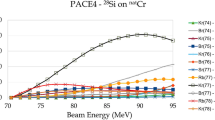Play all audios:

ABSTRACT IN continuation of the experiments on uranium fission under deuteron bombardment reported by Gant1 from this laboratory, we have carried out a chemical separation of the recoil
products. The particles projected from the uranium target under deuteron bombardment were collected on an aluminium foil using the experimental arrangement described by Gant. The foil was
then dissolved in aqua regia and, after adding the necessary carriers, platinum, barium and lanthanum separations were made in the usual way. The activities observed were 15 min., 1 hr. and
30–40 hr. with the platinum fraction, 11 min. and 80 min. with the barium fraction, and 4 hr. with the lanthanum fraction. Some of the periods are thus found to correspond to those obtained
with neutron fission in uranium2, in agreement with Gant's conclusion that 9 Mev. deuterons are capable of producing fission in uranium. Control experiments with lead and bismuth
targets failed to show any appreciable activities in the carriers. Access through your institution Buy or subscribe This is a preview of subscription content, access via your institution
ACCESS OPTIONS Access through your institution Subscribe to this journal Receive 51 print issues and online access $199.00 per year only $3.90 per issue Learn more Buy this article *
Purchase on SpringerLink * Instant access to full article PDF Buy now Prices may be subject to local taxes which are calculated during checkout ADDITIONAL ACCESS OPTIONS: * Log in * Learn
about institutional subscriptions * Read our FAQs * Contact customer support SIMILAR CONTENT BEING VIEWED BY OTHERS HEAVY-ION PRODUCTION OF 77BR AND 76BR Article Open access 03 August 2021
OBSERVATION OF NEUTRON EMISSION DURING ACOUSTIC CAVITATION OF DEUTERATED TITANIUM POWDER Article Open access 21 May 2024 FIRST ON-LINE DETECTION OF RADIOACTIVE FISSION ISOTOPES PRODUCED BY
LASER-ACCELERATED PROTONS Article Open access 14 October 2020 REFERENCES * Gant, _NATURE_, 144, 707 (1939). Article ADS CAS Google Scholar * Livingood and Seaborg, _Rev. Mod. Phys._, 12,
30 (1940). Article ADS CAS Google Scholar * Frisch, _NATURE_, 143, 852 (1939). Article ADS CAS Google Scholar Download references AUTHOR INFORMATION AUTHORS AND AFFILIATIONS *
Cavendish Laboratory, Cambridge R. S. KRISHNAN & T. E. BANKS Authors * R. S. KRISHNAN View author publications You can also search for this author inPubMed Google Scholar * T. E. BANKS
View author publications You can also search for this author inPubMed Google Scholar RIGHTS AND PERMISSIONS Reprints and permissions ABOUT THIS ARTICLE CITE THIS ARTICLE KRISHNAN, R., BANKS,
T. Fission of Uranium and Thorium under Deuteron Bombardment. _Nature_ 145, 860–861 (1940). https://doi.org/10.1038/145860b0 Download citation * Issue Date: 01 June 1940 * DOI:
https://doi.org/10.1038/145860b0 SHARE THIS ARTICLE Anyone you share the following link with will be able to read this content: Get shareable link Sorry, a shareable link is not currently
available for this article. Copy to clipboard Provided by the Springer Nature SharedIt content-sharing initiative
